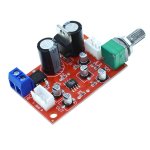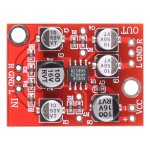Hi i have a question about batteries and capacitors I understand that when a battery is followed by a big capacitor the capacitor at surge acts as a short circuit
I am thinking to use a single 12V SLA battery and a capacitor at its output How many uF can i use in order to avoid problems ?
is there a way to slow down the cap charging cycle ?
thank you very much indeed
I am thinking to use a single 12V SLA battery and a capacitor at its output How many uF can i use in order to avoid problems ?
is there a way to slow down the cap charging cycle ?
thank you very much indeed
Hi thank you All very much for your kind reply and advice
The application will be a small board with an opamp working with voltages from 10 to 24VDC with some 20-30mA of current draw
As i would like to try a SLA battery i understand the issue of the internal impedance not so low and actually i see big caps used in the car audio systems
I would like to understand if placing a let's say 10 mF cap across the battery could damage it at surge when i will switch the preamp on
Of course the more the mF the better
The application will be a small board with an opamp working with voltages from 10 to 24VDC with some 20-30mA of current draw
As i would like to try a SLA battery i understand the issue of the internal impedance not so low and actually i see big caps used in the car audio systems
I would like to understand if placing a let's say 10 mF cap across the battery could damage it at surge when i will switch the preamp on
Of course the more the mF the better
Last edited:
The combination may not pencil out, costwise. I just went to Digikey and priced out a medium-sized (12AH) 12V SLA battery. One will cost you $28 and change. Its internal resistance is specified as less than 40 milli-ohms. So to significantly reduce that you will need a capacitor with an ESR of 4 milli-ohms or less. Again on Digikey, all the ones I found were large, in terms of capacitance -- in the Farad range -- and cost was in the $100 dollar range and up.
Achieving that low an ESR just needs a freaking large capacitor.
Is the cost worth the factor of 10 reduction in output resistance?
FWIW, if you spend $138 on a 33AH battery you will get less than 10 milli-ohms. So just skip the capacitor.
Achieving that low an ESR just needs a freaking large capacitor.
Is the cost worth the factor of 10 reduction in output resistance?
FWIW, if you spend $138 on a 33AH battery you will get less than 10 milli-ohms. So just skip the capacitor.
Hi thank you sincerely I think that this solves the issue and makes me life easierThe combination may not pencil out, costwise. I just went to Digikey and priced out a medium-sized (12AH) 12V SLA battery. One will cost you $28 and change. Its internal resistance is specified as less than 40 milli-ohms. So to significantly reduce that you will need a capacitor with an ESR of 4 milli-ohms or less. Again on Digikey, all the ones I found were large, in terms of capacitance -- in the Farad range -- and cost was in the $100 dollar range and up.
Achieving that low an ESR just needs a freaking large capacitor.
Is the cost worth the factor of 10 reduction in output resistance?
FWIW, if you spend $138 on a 33AH battery you will get less than 10 milli-ohms. So just skip the capacitor.
I see these little boards with 5532 or ad828 etc. I am quite sure that the opamps are fake but the temptation is strong to hear how they sound
I understand that discretes are for those competent and very skillfull experts who are ready to take the challenge
I am quite sure that i am hopeless to get similar performance with discretes I am mostly interested in line stage
A battery could provide the opportunity to check the sound almost immediately Then i could think about a low noise power supply
The pictures of the boards are attached
Attachments
Hi maybe i am exaggerating They have a single ad828 on board Could it be less ?At that current draw you must be talking about a headphone amp?
Mike
Old battery operated class B germanium "power" stage in AJ6 with 4 cell AA only used a small 30uF. Class B has the greatest variation in power drain versus audio ouptut. Agree that those weren't hifi rigs, but did their job. So if your set is class A or AB you will not have issues with a 100uF // 0.1uF.
You never said you were using a video opamp...so yeah, quiescent current draw of that device is around 15mA for both channels, so designing for double is entirely reasonable...and don't for get to add the current draw of the whole circuit in normal operation, especially if it is a low impedance design.
Mike
Mike
Hi thank you very much for your kind and valuable advice I am almost sure that the OA is a fake one I hope it will not explode
The price is not right for a genuine opamp
I think i will order a 10klog Alps, two headphones panel sockets and two red and black speaker panel sockets for power connections
I was surprised to see that a very expensive power amp from FM Acoustic was using simple 4mm panel socket
https://images.hifido.co.jp/13/859/85940/c.jpg
And everything will end inside a junction box 😏
The price is not right for a genuine opamp
I think i will order a 10klog Alps, two headphones panel sockets and two red and black speaker panel sockets for power connections
I was surprised to see that a very expensive power amp from FM Acoustic was using simple 4mm panel socket
https://images.hifido.co.jp/13/859/85940/c.jpg
And everything will end inside a junction box 😏
- Home
- Amplifiers
- Power Supplies
- Batteries and capacitance

